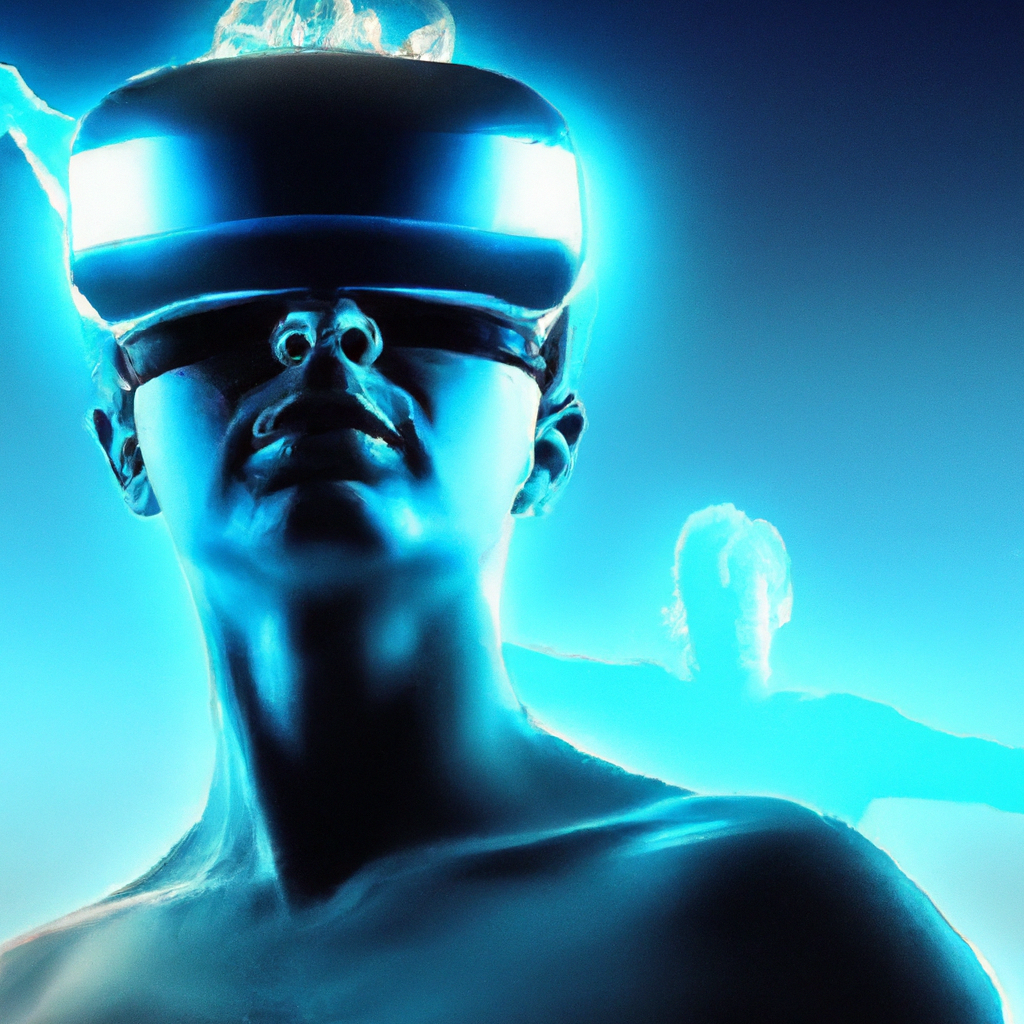Imagine stepping into a virtual reality world where you can feel the warmth of the sun on your skin, hear the leaves rustling as you walk through a forest, and even smell the fresh ocean breeze. This is not just a dream, but the next step in VR technology: total sensory immersion. By incorporating all five senses into the virtual experience, developers are revolutionizing the way we interact with digital worlds, creating a truly immersive and lifelike experience like never before. Let’s dive into the exciting possibilities that total sensory immersion brings and discover how it is reshaping the future of virtual reality.

Understanding the Concept of Total Sensory Immersion in VR
Virtual reality (VR) has come a long way since its inception, and one of the most exciting developments in this field is the concept of total sensory immersion. Total sensory immersion in VR refers to the experience of being completely immersed in a virtual environment, where all senses are engaged to create a realistic and immersive experience. This goes beyond just visual and auditory stimulation, and aims to involve all five senses – sight, sound, touch, smell, and taste – in a seamless and convincing manner.
Defining total sensory immersion
Total sensory immersion can be defined as the state where an individual feels fully immersed in a virtual environment, with all their senses engaged and stimulated. This level of immersion aims to create a sense of presence and realism, allowing the user to feel as if they are really part of the virtual world. In order to achieve total sensory immersion, technology needs to be able to provide high-quality visuals, realistic sound effects, haptic feedback, and even simulate smells and tastes.
Tracing the evolution of immersive technology
The concept of total sensory immersion in VR is built upon the foundation of immersive technology. Immersive technology has been evolving for decades, starting with simple stereoscopic images and progressing to more sophisticated head-mounted displays (HMDs) and motion tracking systems. The goal has always been to create a sense of presence and immersion, where the virtual world feels real and convincing. Total sensory immersion takes this concept to the next level by integrating all senses into the virtual experience.
Drawing a line between VR and total sensory immersion
While VR technology has made great strides in recent years, it is important to differentiate between VR and total sensory immersion. VR typically involves the use of a headset that provides visual and auditory stimulation, while total sensory immersion aims to engage all senses to create a truly immersive experience. While VR can provide a sense of presence and immersion, total sensory immersion takes it a step further by involving touch, smell, and taste, adding an extra layer of realism to the virtual experience.
Current Limitations of VR Technology
As exciting as the concept of total sensory immersion may be, current VR technology still has its limitations when it comes to providing a fully immersive experience.
Exploring the sensory limitations of current VR
One of the primary limitations of current VR technology is the lack of full sensory engagement. While VR headsets can provide high-quality visuals and surround sound, they fall short when it comes to engaging the other senses. Touch, smell, and taste are not yet fully integrated into VR experiences, limiting the overall immersion and realism that can be achieved.
Acceptance and availability issues of current VR technology
Another challenge in achieving total sensory immersion is the acceptance and availability of VR technology. While VR has gained popularity in recent years, it is still considered a niche market and is not yet widely adopted. Additionally, the cost of VR equipment can be a barrier for many potential users, limiting the widespread adoption of total sensory immersion experiences.
Presenting user experiences: comfort and realism
An important aspect of total sensory immersion is creating user experiences that are both comfortable and realistic. Current VR technology often faces challenges in providing comfortable experiences due to issues such as motion sickness, discomfort from wearing headsets for extended periods of time, and limitations in reproducing realistic tactile sensations. Overcoming these challenges is crucial in order to create immersive experiences that are enjoyable and accessible to a wide range of users.
Technological Advances Required for Total Sensory Immersion
In order to achieve total sensory immersion in VR, several technological advancements are required to address the limitations of current technology.
Need for 360-degree visuals and sound
To create a truly immersive experience, VR technology needs to provide 360-degree visuals and sound. This means that users should be able to look in any direction and see a fully rendered virtual environment, without any limitations in their field of view. Additionally, sound should be spatially accurate, allowing users to hear sounds coming from different directions in a realistic manner. Achieving 360-degree visuals and sound is crucial for creating a sense of presence and immersion in virtual environments.
Necessity of tactile feedback systems
One of the biggest challenges in achieving total sensory immersion is providing realistic tactile feedback. Current haptic feedback systems, such as haptic gloves or exoskeletons, are still limited in their ability to reproduce realistic sensations. Advancements in haptic technology are necessary to create realistic touch sensations that can simulate a wide range of textures and physical interactions. This would allow users to feel the virtual world through their sense of touch, further enhancing the immersion and realism of the experience.
Importance of smell and taste simulation in VR
While visual and auditory stimulation can create a convincing virtual experience, the sense of smell and taste are often overlooked. However, these senses play a crucial role in our perception of the world and can greatly enhance the realism of VR experiences. Advancements in scent and taste simulation technology would allow for the creation of immersive virtual environments that not only look and sound real, but also smell and taste real. Simulating smells and tastes can evoke powerful emotions and memories, adding another layer of immersion to VR experiences.
Virtual Reality and Neuroscience
Understanding the relationship between VR and the brain is crucial in developing total sensory immersion experiences.
Understanding the role of the brain in VR experience
The brain plays a fundamental role in our experience of virtual reality. It processes the sensory inputs provided by VR technology and creates our perception of the virtual world. Understanding how the brain reacts to VR stimuli, such as visual and auditory cues, can help in designing more realistic and immersive experiences. Researchers are studying the brain’s responses to VR to gain insights into how to optimize the technology for total sensory immersion.
Decoding sensations: how the brain processes virtual experiences
Virtual experiences can create sensations that feel real, even though they are generated by technology. The brain has the remarkable ability to process these virtual sensations and integrate them with our perception of the real world. By decoding how the brain processes these sensations, researchers can improve the fidelity of VR technology and make the virtual experience more indistinguishable from reality. This understanding can help in developing total sensory immersion experiences by exploiting the brain’s natural processes.
Implementing neuroscience findings in VR technology
Neuroscience findings can be integrated into VR technology to enhance the immersive experience. For example, understanding how the brain processes motion can help in reducing motion sickness in VR. By designing virtual environments that align with the brain’s expectations of motion, developers can create more comfortable and immersive experiences. Similarly, knowledge of how the brain responds to visual and auditory stimuli can be used to optimize the visual and auditory components of VR technology, further enhancing the overall immersion and realism.

Examples of Total Sensory Immersion Technology in Development
While total sensory immersion may still be in the developmental stage, there are already groundbreaking projects and prototypes that are pushing the boundaries of VR technology.
Highlighting groundbreaking projects and prototypes
Numerous projects are underway to achieve total sensory immersion in VR. For example, there are companies developing haptic feedback suits that provide realistic tactile sensations, allowing users to feel the virtual world. Other projects focus on scent and taste simulation, aiming to create immersive experiences that engage all senses. These projects demonstrate the potential of total sensory immersion technology and give a glimpse into the future of VR.
Success and failures in the journey towards total sensory immersion
The journey towards total sensory immersion is not without its challenges. While there have been significant advancements in VR technology, there have also been setbacks and failures along the way. Some projects have struggled to deliver on the promise of total sensory immersion, facing technical limitations or difficulties in creating compelling user experiences. However, these failures serve as valuable learning experiences and contribute to the overall progress in the field.
Pioneers in total sensory immersion technology and their contributions
There are pioneers in the field of total sensory immersion technology who have made significant contributions to advancing the state of the art. These individuals and companies have been at the forefront of developing technologies that engage all senses in VR experiences. Their expertise and dedication have paved the way for future innovations and have brought us closer to achieving total sensory immersion in VR.
Applications of Total Sensory Immersion VR
Total sensory immersion in VR has the potential to revolutionize various fields and industries, opening up new possibilities and opportunities.
Virtual tourism and exploration
One of the most obvious applications of total sensory immersion VR is in the field of virtual tourism and exploration. With total sensory immersion, users can visit far-off destinations and experience different cultures without leaving their homes. They can explore famous landmarks, interact with virtual characters, and get a taste of what it’s like to be in different parts of the world. This has the potential to democratize travel and make it accessible to a wider audience.
Medical and therapeutic uses
Total sensory immersion VR also holds promise in the medical and therapeutic fields. Virtual reality has already been used successfully as a tool for pain management, exposure therapy for phobias, and rehabilitation. By incorporating total sensory immersion, these applications can become even more effective and realistic. For example, in rehabilitation, patients can experience movements and sensations that mimic real-world activities, aiding in their recovery and reintegration.
Education and workforce training
Total sensory immersion VR has the potential to transform education and workforce training. By creating immersive and realistic learning environments, students can experience hands-on training and simulations that were previously not possible. From exploring historical events to practicing complex tasks, total sensory immersion VR can provide a safe and effective learning environment that enhances understanding and retention. It can also be a valuable tool for training professionals in various fields, allowing them to practice in realistic and challenging scenarios.
Gaming and entertainment prospects
Gaming and entertainment industries have already embraced the possibilities of VR, and total sensory immersion takes it to the next level. With all senses engaged, gamers can become fully immersed in virtual worlds, experiencing games in a whole new way. From the thrill of a roller coaster ride to the tension of a horror game, total sensory immersion can enhance the emotional impact of gaming experiences. It opens up possibilities for new genres of games and interactive storytelling that blur the line between reality and the virtual world.

Challenges ahead for Total Sensory Immersion Technology
While total sensory immersion in VR holds great promise, there are several challenges that need to be addressed in order to realize its full potential.
Neurological and psychological risks and concerns
Engaging all senses in VR experiences raises concerns about potential neurological and psychological risks. For example, research has shown that prolonged exposure to virtual environments can lead to a phenomenon known as the “Proteus effect,” where individuals can experience a shift in their real-world behavior and perceptions. Additionally, there may be risks of overstimulation or desensitization when all senses are engaged for extended periods of time. It is important to conduct thorough research and consider the potential risks and ethical implications of total sensory immersion technology.
Technical challenges in developing indistinguishable virtual reality
Creating virtual experiences that are indistinguishable from reality is a major technical challenge. Achieving realistic visuals, sound, touch, smell, and taste is a complex task that requires advancements in multiple areas of technology. From improving display resolution and refresh rates to developing haptic feedback systems that can replicate a wide range of physical sensations, there are numerous technical hurdles to overcome. Solving these challenges will require collaboration between researchers, engineers, and developers from various fields.
Market acceptance and willingness to adapt
Finally, market acceptance and willingness to adapt to total sensory immersion technology will be crucial for its success. While VR has gained traction in recent years, there is still a need for greater awareness and understanding of the potential of total sensory immersion. Additionally, cost and accessibility of the technology need to be addressed to make it more accessible to a wider audience. The success of total sensory immersion in VR will rely on the willingness of consumers and industries to embrace this new paradigm and incorporate it into their daily lives.
The Question of Ethical Considerations
The rapid advancement of total sensory immersion technology raises important ethical considerations that need to be addressed.
Debate over deep immersion and disconnect from the real world
One of the main ethical concerns surrounding total sensory immersion is the potential for individuals to become disconnected from the real world. Spending excessive amounts of time in virtual environments could have implications for mental health and social well-being. It is important to strike a balance between immersive virtual experiences and maintaining a healthy connection with the real world. The ethical implications of deep immersion need to be carefully studied and considered.
Concerns over content creation and censorship
Total sensory immersion technology also raises concerns about content creation and censorship. With the ability to create highly realistic and immersive experiences, there may be a need for stricter regulations and guidelines to ensure that the content produced is ethical and responsible. Additionally, there may be challenges in distinguishing between virtual experiences and reality, raising questions about the potential for misuse or abuse of the technology. Addressing these concerns will be crucial in order to prevent harm and ensure that total sensory immersion technology is used responsibly.
Potential misuse and abuse of total sensory immersion technology
As with any technology, there is always the potential for misuse and abuse. Total sensory immersion technology could be used for nefarious purposes, such as manipulating emotions or inducing addiction. Additionally, there may be concerns about invasion of privacy and surveillance in virtual environments. It is important to develop robust safeguards and ethical guidelines to prevent the misuse and abuse of total sensory immersion technology.

Looking Towards the Future: Total Sensory Immersion in Everyday Life
Despite the challenges and ethical considerations, the future of total sensory immersion in VR holds great potential for transforming everyday life in multiple ways.
Visions of VR integrated lifestyle
A future where total sensory immersion in VR is integrated into everyday life holds exciting possibilities. Imagine being able to work remotely while feeling as if you are physically present in a virtual office, complete with realistic tactile sensations and interactions. Or imagine attending a virtual concert or sporting event, where you can not only see and hear the action, but also feel the vibrations and emotions associated with the event. Total sensory immersion has the potential to revolutionize how we live, work, and experience the world around us.
Societal changes that total sensory immersion VR could bring
Total sensory immersion VR has the potential to bring about significant societal changes. It could redefine the way we communicate and interact with each other, enabling virtual meetings and gatherings that feel as real as face-to-face interactions. It could also democratize access to experiences and opportunities, providing virtual travel and education to those who might not have the means to do so in the physical world. These changes could have wide-ranging implications for social equality, cultural exchange, and global connectivity.
Exploring discipline lines the technology could disrupt
Total sensory immersion VR has the potential to disrupt various disciplines and industries. From healthcare and therapy to education and entertainment, the possibilities are vast. For example, in healthcare, total sensory immersion could revolutionize surgical training, allowing doctors to practice surgeries in realistic virtual environments. In education, it could create immersive learning experiences that engage and motivate students in ways that traditional teaching methods cannot. The technology has the power to transform multiple sectors and challenge existing boundaries and norms.
Closing Remarks: The Possibility of a ‘VR Era’
In conclusion, total sensory immersion in VR represents the next step in the evolution of virtual reality technology. It aims to create immersive experiences that engage all senses, blurring the lines between the virtual world and reality. While there are still limitations and challenges to overcome, advancements in technology and neuroscience are paving the way for the realization of total sensory immersion experiences.
The potential impacts of total sensory immersion VR are vast, with applications in various fields and industries. From virtual tourism to medical training, the technology has the potential to revolutionize the way we work, learn, and entertain ourselves. However, it is important to carefully consider the ethical implications and address the challenges and concerns associated with total sensory immersion technology.
As we look towards the future, a world where total sensory immersion is a part of everyday life seems within reach. It is up to us to shape this future responsibly and ensure that the benefits of total sensory immersion VR outweigh any potential risks. By embracing this technology, we have the opportunity to create a truly immersive and transformative future.











